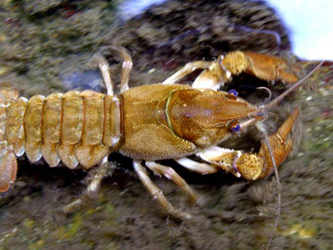Anciently introduced species can be confounded with native species because introduction pre-dates the first species inventories or because of the loss of the collective memory of the introductions. Here, an integrative, multidisciplinary approach was followed to solve the status of a cryptogenic species, proposing that building on evidence from multiple disciplines can produce robust and clarifying insights. An exhaustive review of information was undertaken on a putatively native crayfish (Austropotamobius italicus) in Spain. The reviewed information included taxonomy, genetics and phylogeography, history, archaeology, linguistics, biogeography, ecology, symbiotic organisms and even gastronomy and pharmacy. The knowledge produced by different scientific disciplines converges to indicate that A. italicus is a non-native species in Spain. Historical documents even identify the first introduction event: crayfish were shipped from Italy to Spain in 1588 as a diplomatic gift from Francesco I de' Medici to King Philip II of Spain. Previous discussions on the status of A. italicus focused on inconclusive and often confusing genetic results and excluded the rich and clarifying evidence available from other approaches and disciplines. Interdisciplinarity is an often-invoked but rarely implemented practice in an academic environment that increasingly promotes narrow-focussed specialization. This review shows that the integration of disciplines can surpass disciplinary approaches in solving scientific controversies. Results have straightforward implications for strategies to conserve biological diversity in Spain and Europe, urging a debate on the appropriateness of devoting conservation efforts to non-native species. informacion[at]ebd.csic.es: Clavero et al (2015) Interdisciplinarity to reconstruct historical introductions: solving the status of cryptogenic crayfish. Biol Rev DOI: 10.1111/brv.12205









 Las altas temperaturas están provocando que las lagunas y las marismas de Doñana pierdan agua rápidamente
Las altas temperaturas están provocando que las lagunas y las marismas de Doñana pierdan agua rápidamente



